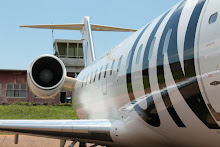Sims Week One
Life seems a little twisted when you're away from home for so long. It has now been eight weeks and the end is finally in sight. The sim is the final phase of training before going on line for IOE.
It's easy to complain about the length of my company's training program, but it really is excellent. Many regional airlines outsource their training. The average length of service for instructors is over seven years.
Our first four sim sessions consisted of practicing cockpit flows, checklists and profiles and procedures. It was all of the basics of flying the aircraft from the beginning to end of a flight. We flew many departure procedures, arrivals and a lot of the things you'd normally do during flight including flight level changes, vectors, flight plan changes, climbs and descents with altitude and speed crossing restrictions, abnormal procedures and a significant amount of ILS approaches.
Our instructor also threw a few things at us including unexpected wake turbulence encounters, thunder storms, turbulence and wind shear.
The procedures validation was pretty straightforward. We started with a cold, dark airplane. Then had to pick up a clearance, push back, start the engines and taxi. He gave me a slow hot start. That's where the inter-turbine temperature (ITT) goes too high after fuel is introduced. The procedure is to put the thrust lever to shut-off, turn off the ignition and dry motor (leave starter running) the engine until the ITT is below 120C or until the starter has been running for 60 seconds. Next, you run the QRH procedure, then call maintenance.
During taxi, runway visual range (RVR) dropped to 600 feet. With visibility below 1200 RVR, a takeoff alternate is required. Also in order to take off with 600 RVR, center line lights and runway center line markings are must be adequately visible. For a low visibility takeoff, the brakes must be held until thrust is at 70%.
We took off from CVG on runway 18L and did the Bluegrass 8 departure. After a series of vectors and altitude changes, we were cleared to our final altitude. Once at cruise, the instructor gave me a pack low press caution. After that, he gave me a GEN 2 FAIL caution. We handled both of the procedures and were then vectored back to CVG for an ILS. Visibility was lower than reported and we ended up going around and flying the published missed. We were then vectored around for another ILS to minimums and landed.
That was the end of my portion of the procedures validation. After a ten minute break, it was my partner's turn to do the same thing and his went well too. We both passed and are ready to move on.
The next step is the maneuvers stage which is four sims sessions followed by the maneuvers validation. The MV conducted by a check airman and is a pass/fail checking event. We will be expected to perform rejected takeoffs, V1 cuts, single engine approaches and missed approaches and other tasks that are determined by the check airman. From what I've heard, the MV is a bigger deal than the actual check ride, which is called a line-oriented event (LOE). The LOE is the final event and is basically a typical flight between a city pair.
If anyone has any questions about airline training that haven't been answered here, feel free to ask. I'll do the best to answer them based on what I've experienced over the past few months.
--
After finishing the PV, I hopped a flight home to see my wife and kids. It was another quick trip, but worth it. I actually had to fly through Los Angeles to get home. An extra two hours of flying got me home 5 hours earlier. The worst part of the trip was getting a middle seat from CVG to LAX. The guy in the aisle seat was over 300 lbs and made me look anorexic. Needless to say, it was kind of uncomfortable. On the way back today, I was luck enough to get an aisle seat in the emergency exit row. Ahh...legroom.

4 comments:
You make it sound very easy. 1-2-3! However, I know there's a lot of sweat equity invested. Glad you got home for a bit. JP
Ahhhh, the light at the end of the tunnel. Keep focused and fly the flight director, it'll all be over soon and then the real world learning will begin.
What is a take off alternative? I've not heard of that. And if vis is so bad at your takeoff point, is it hard to find an alternate?
Windsor,
Flight director and flight mode annunciator are the keys to RJ success. One more week!
Anonymous:
A takeoff alternate is required when visibility is below approach minimums for the departure airport. If it's too low for a return in the event of an emergency, you'd sure want to have a backup plan.
For instance, if you're doing a low-visibility takeoff with 600/600/600 runway visual range (RVR) and the airport's ILS approach minimums are 1/2 mile, you would need to file a takeoff alternate because 1/2 mile = 2400 RVR...much more than 600!
In order to file the alternate for a two engine jet from a 121 carrier, you must be able to fly to the alternate within one hour, in still air with only one engine operating.
I hope this answers your question.
Post a Comment